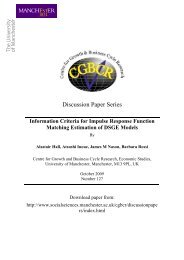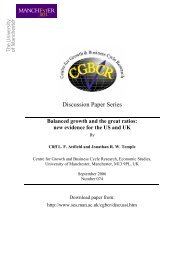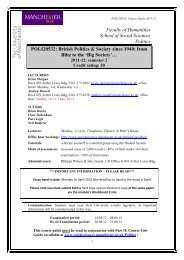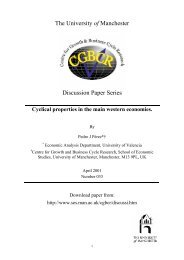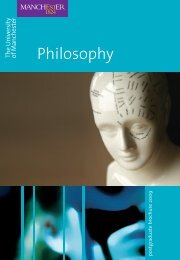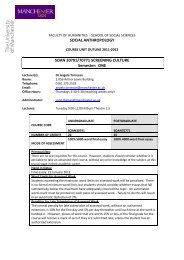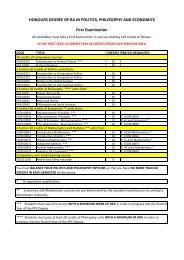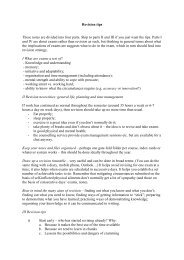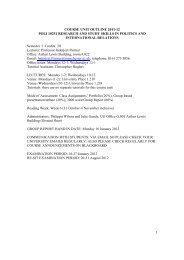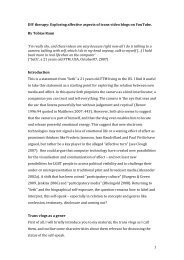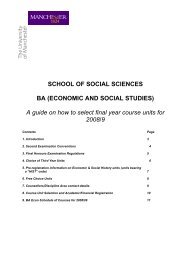CHNN 22, Spring 2008 - School of Social Sciences
CHNN 22, Spring 2008 - School of Social Sciences
CHNN 22, Spring 2008 - School of Social Sciences
Create successful ePaper yourself
Turn your PDF publications into a flip-book with our unique Google optimized e-Paper software.
Andree Levesque, Red Travellers: Jeanne Corbin & Her Comrades (Montreal and<br />
Kingston: McGill-Queen’s University Press, 2006), 232 pp., £20.95, hardback, ISBN<br />
9780773531253.<br />
H<br />
aving reviewed the original French language version <strong>of</strong> this book (Scenes de la vie en<br />
rouge: L’epoque de Jeanne Corbin, 1906-1944) in the <strong>Spring</strong> 2001 issue <strong>of</strong> <strong>CHNN</strong>, I’m<br />
pleased to see it translated into English as one <strong>of</strong> McGill-Queen’s Footprints series. I can<br />
confirm my initial, positive response, but while the book has a new and improved title, it has been<br />
reprinted apparently with no re-editing, and I feel obliged to admit that some misspellings and<br />
inaccuracies I missed the first time around have survived translation.<br />
Without looking too hard, I spotted trade unionist Mary McNab rendered as Mary “MacNabs” and<br />
socialist Beatrice Brigden as “Bridgens” (p151); changes in the content <strong>of</strong> the Daily Clarion – first<br />
published in May 1936 – are said to have happened ‘by 1935’ (p153), and referring to a Congress <strong>of</strong><br />
the ‘red’ Lumber Workers’ Industrial Union <strong>of</strong> the Workers Unity League that took place in 1931,<br />
‘Congres de l’Union industrielle des travailleurs forestiers’ (page 90 in the original version) is<br />
mistranslated as ‘the forestry workers’ union <strong>of</strong> the CIO’ (p57). The CIO was formed in 1935.<br />
Over all, these are minor irritants. The Footprints series aims to use the ‘life stories <strong>of</strong> individual<br />
men and women who were participants in interesting events’ to ‘help nuance the larger historical<br />
narratives.’ Red Travellers account <strong>of</strong> the Communist Party’s struggles to make the revolution in<br />
Quebec and northern Ontario adds considerable nuance to the historiography <strong>of</strong> communism and<br />
Depression-era Canada. The final chapter on Jeanne Corbin’s last struggle, against tuberculosis, is<br />
very moving.<br />
John Manley, University <strong>of</strong> Central Lancashire<br />
Robert Service, Comrades: A World History <strong>of</strong> Communism, (London: Macmillan<br />
2007), ppxviii+570, ISBN 798-1-4050-5345-7, £25.hbk.<br />
T<br />
he communist movement <strong>of</strong> the twentieth century was a unique historical phenomenon: a<br />
militantly secular but theoretically-based and organised collective <strong>of</strong> individuals active<br />
throughout the entire world, animated (at least formally) by the common aim <strong>of</strong><br />
overthrowing, violently or otherwise, the established states inherited from the nineteenth century<br />
or earlier, and then proceeding to the total transformation <strong>of</strong> economic and social relations – which<br />
did not <strong>of</strong> course exclude bitter internecine disputes and accusations <strong>of</strong> renegacy.<br />
Certainly this movement deserves a lengthy and comprehensive critical history and analysis; <strong>of</strong> its<br />
ruling parties, its non-ruling parties, its relations with political friends and enemies and with<br />
society at large – but most emphatically this volume does not come into that category. It is a truly<br />
astonishing piece <strong>of</strong> work to be produced by someone <strong>of</strong> Service’s reputation and qualifications. In<br />
short, it is flawed in any number <strong>of</strong> dimensions and fails altogether in its purposes.<br />
Comrades aspires to be a narrative account <strong>of</strong> the communist movement from its earliest<br />
precursors to its debacle at the end <strong>of</strong> the twentieth century. It is, however, rattling with factual<br />
errors and gross distortions <strong>of</strong> events, <strong>of</strong> which I counted nearly seventy (leaving aside typos, minor<br />
distortions, ambiguous formulations and syntactical infelicities). It would be tedious to catalogue<br />
every one (though I would be happy to supply a full list to anyone interested). What follows<br />
therefore is a sample <strong>of</strong> the most egregious:<br />
Wrong date for the publication <strong>of</strong> Capital (p27); Gramsci was not a Sicilian but a Sardinian (p92)<br />
and, as Seamus Milne pointed out in his Guardian review, he did not die in prison; Lenin did not<br />
die <strong>of</strong> a heart attack but <strong>of</strong> a stroke (p97); The Nazis’ highest vote was not in November 1932, but in<br />
July, their November vote diminished markedly (p172); Churchill’s government did not ban the<br />
CPGB’s press, but its daily paper (p216); the Warsaw Pact is represented as existing in the late<br />
1940s (p255) (though elsewhere the correct timing is given); the Black Sea is said due to pollution<br />
to have been dangerous to swimmers and lethal to fish (p364). The latter is perfect fantasy. I have<br />
swum in it myself (in 1987) and seen hundreds <strong>of</strong> others doing the same, watched fish being caught<br />
56



